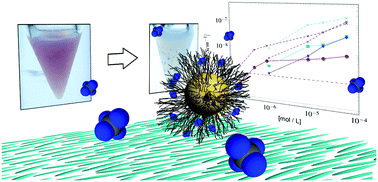Why organically functionalized nanoparticles increase the electrical conductivity of nematic liquid crystal dispersions†
Abstract
Doping liquid crystals with gold nanoparticles increases the conductivity by up to three orders of magnitude, an increase even stronger than expected for equimolar amounts of organic electrolytes. Despite recent high activity in the field of liquid crystalline nanocomposites, the origin of this increase has rarely been addressed and is not well understood. In this dielectric spectroscopy study we discuss the origin of the increased conductivity and identify its source. We demonstrate that the hydrodynamic radius of the mobile charge carrier species in nanoparticle dispersions is significantly smaller than the 3–5 nm gold core, which rules out the particles themselves to be the source of conductivity. Likewise, also the ligand molecules from the organic capping layer do not themselves add to the conductivity of the dispersions, but affect the electrical properties by acting as a trap for ionic impurities. We suggest that the partial release of these impurities upon interactions of the ligand shell with the uniaxial nematic host phase is the most likely source for the increased conductivity. Our study opens a new perspective on synthesis strategies for functionalized nanoparticles and will help to overcome the current issues preventing high-performing liquid crystal nanodispersions.



 Please wait while we load your content...
Please wait while we load your content...